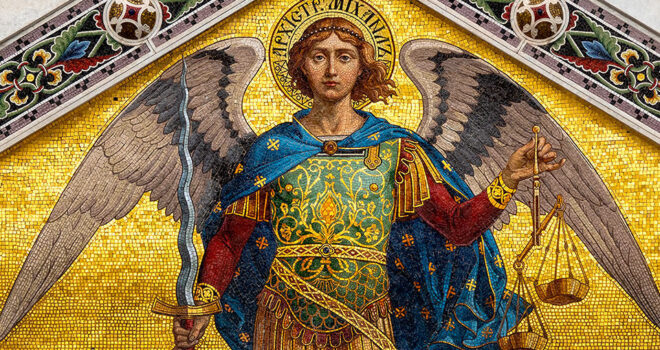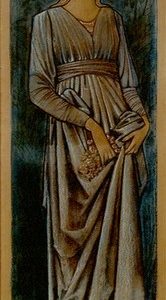When Saint John Paul II called for Catholics to again embrace the prayer to Saint Michael the Archangel, he did so to strengthen the church for spiritual battle. The prayer, written by Pope Leo XIII, fell out of favor after the Second Vatican Council, but is now frequently recited after Mass by many churches. The return of this traditional prayer restores devotion to a powerful servant of God.
Pope Francis calls Saint Michael the “mighty victor over the powers of evil.” Saint Alphonsus Liguori says, “[Michael] has been appointed by God to defend his faithful servants in their last combat with the devils.”
While it can be uncomfortable to talk about evil, devils, and even angels in contemporary and secular society, the Church is clear that evil exists. The church is also certain that Saint Michael is the Guardian of the Faith. Leo XIII’s prayer is a bold appeal to the Archangel to protect us against all evil. By praying for his intercession, the faithful place their trust in the commander of the Army of God.
In celebration of his recent feast day, the Norbertines invite Catholics to deepen their devotion and reliance on this powerful Archangel.
While this spiritual warrior is at work against the forces of evil in the world, Saint Michael has another role in history. Early Christians were just as likely to appeal to Saint Michael for assistance against illness as to plead for his help in defending the faith. This was especially true in relation to plagues and pandemics.
In 590, Rome suffered as a plague swept through the city. One of the plague’s many victims was Pope Pelagius II. The new Pope, Gregory I, believed that “whenever a mighty is in question, Michael is assigned.” He led a penitential procession through the city. The marchers carried an image of Our Lady which was believed to have purified the air. As the procession approached Hadrian’s Mausoleum, Pope Gregory I saw Saint Michael on the top of the building, sheathing his sword. Gregory believed this was a sign that the plague was over. When this proved to be true, and the city was saved, Gregory erected a statue of Saint Michael on top of the building—now known as Castel Sant’Angelo.
Over a thousand years later, and 6,000 miles away, another rampant disease provoked a procession that led to an apparition of Saint Michael in Mexico. This 17th century appearance is an essential moment in the country’s miraculous history.
In Mexico, despite the secular brutality after the revolution that led to the Cristero War, Catholicism was essential to the national identity. Cathedrals and churches hold pride of place in the central zocalos of cities and villages throughout the country. Shrines are set up in businesses, schools, and parks as well as dotting street corners and the sides of highways. Rosaries are often seen hanging from taxi cabs’ rearview mirrors, and passersby cross themselves as they walk past Catholic churches.
The country’s Catholicism is a visceral faith, marked by a history of miracles and apparitions. From Our Lady of Guadalupe to the Our Lady of Ocotlán, the miraculous feels interwoven with the everyday, bringing a sense of wonder to the commonplace. The 1631 apparition of Saint Michael in San Bernabe Capulo is another example of God’s presence in Mexican history.
The village where the Archangel appeared is situated in Tlaxcala, the smallest of Mexico’s states. The history of the state is controversial in Mexico because the Tlaxcaltecs sided with Cortes against the Aztecs. Among the first converted to Christianity, Tlaxcala has a long history of Catholicism.
As a smallpox pestilence the locals called cocolixti ravaged the population, Catholics turned to their faith. On April 25th, they held the procession of the Greater Litanies. These litanies, instituted by Pope Gregory I, were to seek God’s assistance in times of plague and sickness.
As the procession was ending, Saint Michael made his presence known to Diego Lazaro, a 17 year-old youth. This young man not only saw the Archangel but heard him as well, speaking in the youth’s native language. Michael told him of a miraculous spring that could be found under a boulder in a nearby ravine. He ordered the young man to share the message with everyone.
While Diego’s first response was a sense of wonder, his spiritual rapture was soon overcome with doubt. Who would believe someone like him? Why would the angel have come to a 17 year-old farmer? And why had no one else witnessed the apparition? Diego’s doubts weakened his courage. He told no one.
But Saint Michael had selected Diego for a purpose, and the Archangel was not going to allow the young man to escape his calling. He appeared to Diego again, demanding to know why he’d failed him. Saint Michael warned Diego that he would suffer the cocolixti.
Diego immediately fell ill, and his family feared he would die. At the moment when Diego’s situation seemed most desperate, the Archangel removed Diego from his house, transporting him to the boulder where he told Diego the spring would be found. Michael removed the stone, and Diego drank the water. He was cured.
The young man’s fear of not being believed was well founded. A Franciscan friar who’d heard the story sent Diego to the governor of Tlaxcala to share news of the miracle, but the governor refused to accept the story as truth. Diego, now convinced of the validity of the apparition, would not be prevented from sharing Saint Michael’s message. With family and friends, he traveled to the spot where Michael had said the spring would be.
A boulder was blocking the water and the group could not move it. Diego asked them to stand aside and, after appealing to Archangel, moved the boulder and unblocked the spring.
Soon, the water from the spring began to cure the cocolixti, but Diego still did not return to governor of the state. At this point, Saint Michael appeared to Diego one more time, demanding again why he would not do exactly as he’d been instructed. The Archangel was adamant; Diego needed to tell everyone about the spring.
Avoiding the disbelieving governor, Diego took a jug of the water to Don Guitierre Bernado Quiroz, the bishop of Peubla. The bishop, impressed by Diego’s sincerity, believed the youth and distributed some of the water to people suffering from the disease. When multiple cures were reported, the bishop instigated the first of three investigations that each fully supported the validity of the apparition and the miraculous nature of the spring.
Within a year, the first chapel was built at San Miguel del Milagro. The site of the spring soon became a pilgrim spot, attracting believers throughout Mexico. Ten years later, a larger chapel was built on the spot, which still stands today. The month of September and especially the 29th, the Archangel’s feast day, attract a multitude of pilgrims to drink from the miraculous spring and give thanks to Saint Michael.
Once he overcame his initial doubts, Diego spent the rest of his life spreading the news of his encounter. He is buried at the chapel where the spring he uncovered still pours forth miraculous waters.
Some Catholics may feel their own version of Diego’s doubts. Some may turn away from responding to the power of God’s Archangel, but evils and pandemics are not things of the past. To overcome doubts and fears, turn to Saint Michael, appeal to him using Leo XIII’s prayer—a powerful weapon against Satan. Follow in Diego’s footsteps, throw aside doubt, and put your trust in the power of the Archangel Michael.
Author’s Note: To help you pray the Rosary easily, download the free Rosario app, which lets you create or join a Living Rosary group with 4 friends and family members, dividing the meditation of the 5 daily mysteries, one decade each, so that together you pray a Rosary a day!
Mosaic of the Archangel Michael (Northern entrance of the Church of Saint Spyridon, Trieste, Italy). iStock photo.










